Sometimes it’s called “getting in the zone.” Sometimes it’s called “treeing.” Sometimes it’s called being “en fuego.” On Sunday in Melbourne, Mischa Zverev found a new way to describe the sensation that tennis players feel when they find themselves unable to miss a ball.
“I was in a little coma out there,” Zverev said.
If that’s true, no one in a coma, “little” or not, has ever moved as quickly, or hit so many shots as brilliantly, or exploded our idea of what’s possible on a tennis court these days as thoroughly as Zverev did in his 7-5, 5-7, 6-2, 6-4 upset of top-seeded Andy Murray at the Australian Open. The German played a version of the sport that was simultaneously old-school and never-before-seen.
Zverev is 29, which means he’s old enough to remember a time when the serve-and-volley game was used successfully. On Sunday, he set about proving that the style is still viable, even against one of the tour’s very best baseliners and returners.
Just as important, Zverev showed how much fun serve-and-volley can be to play and to watch. He came up with so many sublime strokes, and so many that we rarely see today, that he looked at times as if he were playing trick-shot, exhibition tennis. In reality, Zverev was playing a utilitarian, smotheringly effective game. It wasn’t that Murray was so bad; he just didn’t have any sustainable answers for what his opponent was doing.

